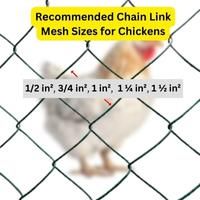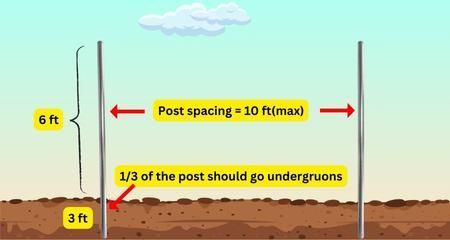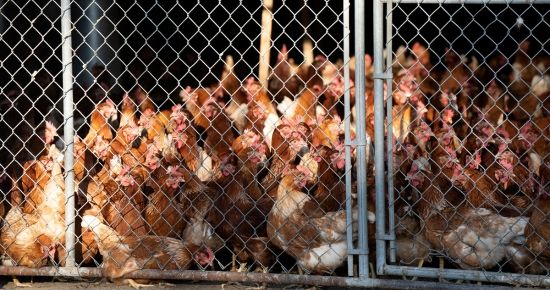Chain link fences are made of thick gauge galvanized steel wires bent into a zigzag pattern (W shape) woven & vertically linked together, creating a flexible and sturdy mesh structure. However, many people may think, are chain link fences useful for containing chickens? Yes. The thick wire and unbreakable woven mesh structure make chain link fences highly useful for making chicken fences & more secure than standard chicken wire. In conclusion, the chain link fence is ideal for secure chicken enclosures; you just have to think about installing it sturdily.
Here are the most important steps for making a DIY chain link chicken run:
- Deciding the layout
- Mesh size
- Chain link wire gauge
- Tightly installing fence
- Securing the top and bottom
- Making the fence predator-proof
To prevent all the hustle, you can also use a chain link dog kennel to build a highly secure chicken run.
We’ll guide you through 10 core tips to help you make a sturdy & secure chicken enclosure.
10 Essential Tips to build a chicken fence with chain link
To keep your chickens safe, the enclosure must be made with a high-quality wire fence & the chain link fence has all the characteristics. Unlike welded mesh wires, chain link is unbreakable because instead of welding, it’s made of thick metal wires woven into each other.
Here are some factors to consider while buying chain-link fence material for your chicken run & making the enclosure highly protected.
1: Chain link mesh size for chicken fences
The mesh size (diamond-shaped openings)& is commonly available in 1-3 square inch mesh sizes. However, smaller mesh sizes provide better protection. A mesh size of 1/2 inch, 1 inch, and a maximum of 1.25 inch are ideal for chicken fencing. You can also use large mesh size(up to 2 inches) depending on the size of the chickens, the desired safety level, and the type of predators & by using thick gauge chain link mesh.
Except for medium-sized predators like cats, coyotes & raccoons that usually attack chickens through the mesh, small animals, such as snakes, rodents & weasels, can even pass through the mesh. However, remember that the mesh size is not the only factor to consider. The chain link wire gauge is also crucial.
2: Chain link gauge for a chicken fence
Chain link fences are commonly available in 6 to 13 gauges. The lower gauge wire will be thicker & stronger, ultimately increasing the price. For example, a 9 gauge is thicker & stronger than an 11 gauge.
For a backyard chicken fence, the ideal gauge of chain link wire is 11 or 11.5 gauge. This wire thickness strikes a good balance between affordability and strength, making it suitable for containing chickens.
These gauges are strong enough to withstand normal wear and tear and provide security against common predators.
3: Decide the size of the fence:
Depending on the chicken’s breed & size, 3 to 5 square feet of space in a coop should be allocated per chicken. For the outdoor chicken run, more space should be provided, such as 8-10 feet per bird. Hence, for 5 chickens, the coop should be 15-25 square feet, while the chicken outruns should be 40-50 square feet.
While deciding the fence size, think about whether the chicken coop will be placed inside or will be attached from outside. Remember, there’s no hard & fast rule for spacing, but make sure that the chickens can easily rest in the coop & can freely exercise in the run.
4: Height of chain link for chicken:
Chickens can jump up to 6 feet or even higher, depending on the breed. Such as breeds like RIR & Australorp are agile and can jump up to 5-6 feet. Plymouth can jump slightly less. While other heavy breads are not comfortable with jumping.
So, as per stats & my personal experience, chickens can fly up to 6 feet. It also depends on the area you a lot to the chicken. In smaller-sized chicken runs, birds can’t take off their flight. Hence, whether installing a chain link fence or any, the optimum height of the chicken fence should be at least 6 feet.
5: Types of posts:
Depending on the desired strength & budget, you can use round metal posts, T-posts, or wood posts. Round metal posts are commonly used for chain-link fences. As a general rule, the gauge of metal posts should match the chain link fence wire.
For short area fencing, i.e., 16 gauge round metal posts will work, while for a slightly large chicken enclosure, 13 gauge metal posts can be used at corners. If using wood posts, they will be set in concrete. Or, if you want to drive them, get one with a sharp end.

How deep to drive posts?
To make the fence have greater strength & bear more weight, posts should be adequately underground. Chain link fence posts can be set in concrete or driven into the ground.
For any type of post you choose, ensure they are at least 3 feet higher than your fence because 1/3 of the post must be under the ground.
Chain link post spacing:
Chain link fence posts can be spaced a maximum of 10 feet apart. So, decide the number of posts required according to the measured fence perimeter. You can increase spacing by driving the posts adequately(more than general).
Tools to drive fence posts:
A manual or electric post driver is used for driving posts depending on the ground hardness & number of posts. For a few posts in soft ground, you can use a manual post driver, while for hard ground & installing a greater number of posts, you can use an electric post driver.
As the corner posts & gate posts have to bear more pressure, make sure that the corner posts are studier(thicker) than the line posts & have a larger diameter.
6: Secure the bottom of the chain link chicken fence:
One of the most important precautions while installing chicken fences is to secure the bottom to keep the fence hooked to the ground & prevent digging predators from entering the chicken fence.
Two precautions are generally taken to secure the bottom & prevent digging predators.
-
Burry the bottom of the fence:
In the first method, bury a few inches of chain link fence under the ground.
- For this purpose, you’ll have to dig a few inches deep trenches along the fence line before tying the chain link to the posts.
- Then, place the fence in it. Stretch the fence & attach it to the posts.
- At last, fill the trench & compress the ground again, using a hand compactor to pound the soil.
-
Attach mesh wire horizontally:
In another way, a piece of hardware cloth is horizontally attached at the bottom end of the fence.
- Take 2-3 feet of wire cloth(wire mesh), according to the length of the fence.
- Then, horizontally attach that wire cloth at the chicken fence’s bottom using pieces of metal wire.
- Finally, bury that wire cloth under the soil & place heavy objects like stones all around the fence.
7: Stretch the fence & attaching it to posts:
Before attaching, stretch the chain link fabric tightly during installation using a fence stretcher tool. Proper stretching ensures the fabric is taut and reduces sagging.
The way & tool for attachment depends on the type of posts. Tension bands & brace bands are commonly used to attach chain link fences to round metal posts. You’ll need 2 tension bands per post. However, tension braces are slightly larger, keeping the chain link fence away from the posts. As a DIY alternative & quick fixture, you can use stay-tuff round post clips.
If using T-posts to support your fence, you can use T-post clips to attach chain link fence to T-posts. If you’ve installed wood posts, heavy-duty fence staples can be used to attach wire fences to wood posts.
How to prevent sagging:
To prevent sagging, you can install tension wire at the top & bottom of the posts. The top of the fence will get hooked to the tension wire, especially when there is no top frame bar(pipe).
Just bend the top corners of the chain link fence around the tension wire. Thick gauge low-carbon metal wires are used to install tension wires.
Tension wire securely holds wire fences from sagging.
8: Installing gate
You can use a readymade chain link pipe gate or build a custom gate. Make sure that the gate fits snugly & there is no excessive space for small animals to trespass. Use high-quality gate posts, as they’ll bear more weight.
Gate post hinges are used to attach gates to posts. Hinges are available for metal & wood posts & gates. You’ll need two male hinges & two female hinges for a gate.
Attach male hinges to posts & female hinges to the gate. Then, the gate hinges get hooked to the post hinges.
9: Cover the Top
Wire mesh is sturdy as well as lightweight; hence is ideal for covering the top of chain-link chicken fence against flying predators such as hawks & eagles.
Once, I had covered my dog’s kennel chicken run with an 18 gauge welded wire & it worked well. I extended it from top to bottom & tied it to the chain link fence & posts using pieces of metal wires.
If you are concerned about providing shade to your chickens, cover the top mesh wire with a tarp, shade cloth, or any plastic sheet. However, ensure the shade is flat & tightly attached; otherwise, water will accumulate at the top. Simply place it over the fence wire at the top & tie the corners to the frame or corner posts using rope or metal wire pieces.
To protect the chicken fence from rain, you can use corrugated metal sheets(zigzag), polycarbonate roof panels, or metal roof panels. However, ensure that the fence panels are enough so they come over the frame & don’t exert pressure on the top wire fence.
10: Making the chain link fence predator-proof
However, if using a large mesh chain link fence(2 or 3 inches), cover the lower part through the inside or outside using chicken wire or any smaller mesh-sized hardware cloth up to at least 3 feet. It’ll prevent any small preying creature from entering your chicken pen.
If you live in an area with bear attack possibilities, it’s wise to install electric fence wire around the chain link fence. It’s because chain link is durable against small to medium-sized predators, while bears can easily destroy chain link fences. An electric fence zap can keep any size of a predator away.
Option 2: Using chain link dog kennels for chicken enclosure:
A lot of people also use dog kennels for chicken fences. They are available in different sizes, such as 10×10 feet, that’s enough for keeping 10-15 chickens. They are made of chain link fence and have a galvanized welded pipe frame, so you don’t have to make a structure on your own. You just have to cover the top and secure the bottom against digging animals.
The top can be covered with welded mesh wire. Make sure that the welded wire extends from the top. After completely covering the top, bend the mesh wire down over the chain link fence & tie them using pieces of metal wires or zip ties.
To attach the top of your chain link fence to the top frame of the dog channel or any pipe frame, wrap a metal wire tightly around the bars in a spiral (loop) shape from one end to the other. Then, pliers bend the top edges of the chain link fence around that metal wire. It will securely hook the chain link fence to the top & prevent it from sagging.
Conclusion
Chain link chicken fence is a highly secure option for chicken runs. The main thing is making a sturdy, predator-proof enclosure from every corner. The main thing is choosing the right mesh size & gauge of chicken wire.
As the chain link fence is heavier, you should use high-quality posts so they can bear weight. Securing the bottom to prevent animals from digging & covering the top from preying bords is quite essential. For large predators like bears, installing electric fence wires can be highly helpful.
If you still need any assistance, ask us in the comments.
Related Posts:

